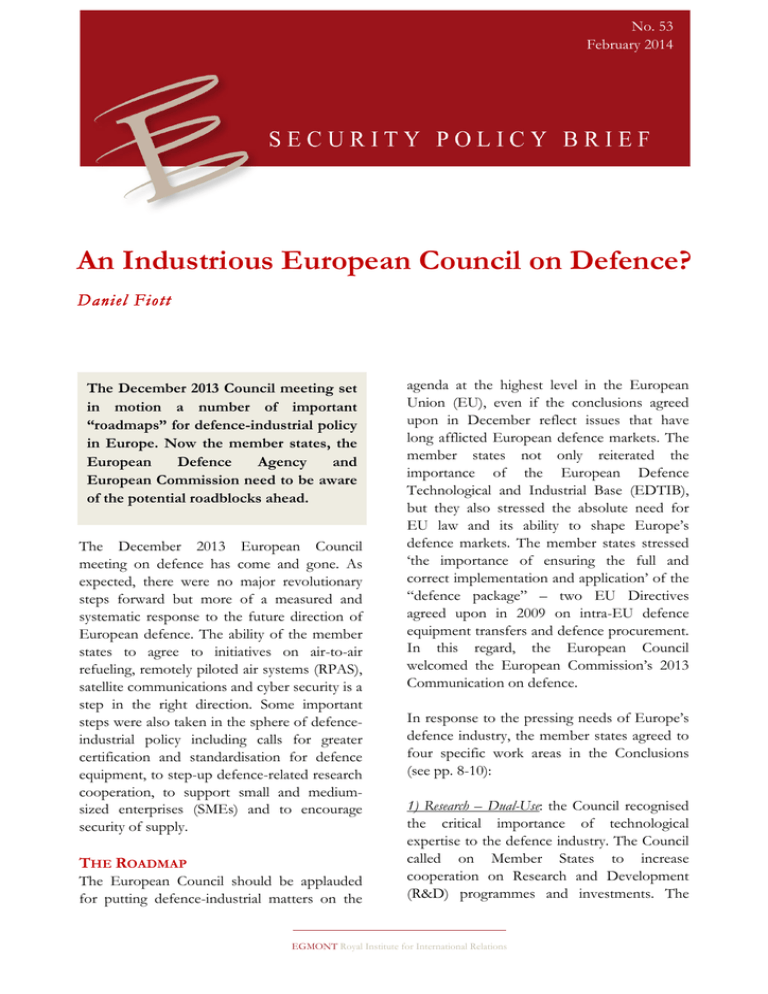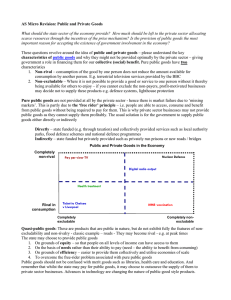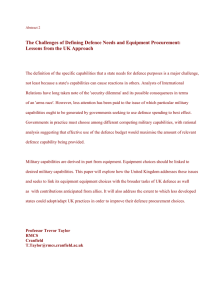
No. 53
February 2014
An Industrious European Council on Defence?
Daniel Fiott
agenda at the highest level in the European
Union (EU), even if the conclusions agreed
upon in December reflect issues that have
long afflicted European defence markets. The
member states not only reiterated the
importance of the European Defence
Technological and Industrial Base (EDTIB),
but they also stressed the absolute need for
EU law and its ability to shape Europe’s
defence markets. The member states stressed
‘the importance of ensuring the full and
correct implementation and application’ of the
“defence package” – two EU Directives
agreed upon in 2009 on intra-EU defence
equipment transfers and defence procurement.
In this regard, the European Council
welcomed the European Commission’s 2013
Communication on defence.
The December 2013 Council meeting set
in motion a number of important
“roadmaps” for defence-industrial policy
in Europe. Now the member states, the
European
Defence
Agency
and
European Commission need to be aware
of the potential roadblocks ahead.
The December 2013 European Council
meeting on defence has come and gone. As
expected, there were no major revolutionary
steps forward but more of a measured and
systematic response to the future direction of
European defence. The ability of the member
states to agree to initiatives on air-to-air
refueling, remotely piloted air systems (RPAS),
satellite communications and cyber security is a
step in the right direction. Some important
steps were also taken in the sphere of defenceindustrial policy including calls for greater
certification and standardisation for defence
equipment, to step-up defence-related research
cooperation, to support small and mediumsized enterprises (SMEs) and to encourage
security of supply.
THE ROADMAP
The European Council should be applauded
for putting defence-industrial matters on the
In response to the pressing needs of Europe’s
defence industry, the member states agreed to
four specific work areas in the Conclusions
(see pp. 8-10):
1)
1) Research – Dual-Use: the Council recognised
the critical importance of technological
expertise to the defence industry. The Council
called on Member States to increase
cooperation on Research and Development
(R&D) programmes and investments. The
EGMONT Royal Institute for International Relations
Council also invited the Commission and
European Defence Agency (EDA) to develop
policies that would stimulate dual-use research,
and it announced that a preparatory action on
Common Security and Defence Policy
(CSDP)-related research would be set up.
2)
2) Certification and Standardisation: the Council
acknowledged that the development of
European standards and certifications for
defence equipment could drive down costs,
harmonise
demand
and
enhance
interoperability. On this basis, the Council is
waiting for a joint EDA-Commission roadmap
on defence standardisation, which should be
ready by mid-2014.
3)
3) SMEs: the Council recognised that SMEs
can be a source of innovation and are vital to
the EU’s competitiveness. The Council
welcomed the Commission’s proposals on
promoting greater defence- and securitymarket access for SMEs. It also strongly
encouraged more involvement by SMEs in
future EU funding programmes.
4)
4) Security of Supply: the Council emphasised
that without security of supply in defence
markets there could be no development of
long-term planning, cooperation or the proper
functioning of the internal market. The
Council called on the EDA, European
Commission, Member States and the High
Representative to design a roadmap for a
“comprehensive EU-wide Security of Supply
regime”.
THE POINT OF DEPARTURE
The December Council could not have come
at a more important time for the defenceindustrial sector in Europe. Indeed, the EDA
recently estimated that the total level of
defence expenditure across the 26 participating
member states of the Agency decreased by
€1.1 billion in the space of a single year from
2011-2012. A total of €189.6 billion was spent
on defence in 2012; the lowest amount since
2006. R&D and Research and Technology
(R&T), critical components of Europe’s
defence-industrial evolution, also decreased
sharply. From 2006 to 2012, R&D saw a 38%
decrease in expenditure levels whereas R&T
decreased by 27.4% (European Defence
Agency, 2013). Most of the key factors that go
into strengthening the EDTIB are on the
wane. On top of these reductions are the
extant problems of market fragmentation,
capability
duplication,
procurement
transparency, etc.
The problem is deeper, however, when one
looks at the state of Europe’s prized defenceindustrial champion: the European Aeronautic
Defence and Space Company (EADS).
Following the failed 2012 merger between
BAE Systems and EADS, and the subsequent
moves by EADS to re-balance the state-toprivate composition of their board, in May of
this year the company will effectively off-load
its defence-related business and take up a new
name: Airbus Group. This is hardly the
inspirational company name that was meant to
symbolise private and state defence
cooperation in Europe. Airbus Group will
focus mainly on civilian aerospace now.
The recent of history of EADS is a good
barometer of all that is wrong with the defence
industry in Europe. With low demand for
military equipment, the high costs of R&D and
technology development and increasing
international competition EADS has no choice
but to make rational decisions based on the
current state and future forecasts of the
defence sector in Europe. EADS is
consolidating its defence portfolio by bringing
together Airbus Defence and Space, Astrium
and Airbus Military in order to cut costs in the
face of a lack of demand: as one might say,
while the “strategic direction is away, the
markets
will
play”.
Defence-industrial
consolidation in Europe is currently rudderless
and without political direction, so the markets
are steadily ensuring that Europe’s defence
EGMONT Royal Institute for International Relations
2
firms turn away from military business in
favour of civilian contracts.
Demand is the key to keeping companies such
as EADS, with their wealth of virtual and
human technological know-how and capital, in
the defence sector. Yet quite how the EU
member states foresee themselves giving
direction to and consolidating their future
military capability needs is still an unanswered
question. True, the December Conclusions talk
about the need for more coherent defence
planning across the member states; both within
the EU and NATO. However, the emphasis
has been placed on the naming of collaborative
armament projects such as RPAS. To be sure,
such projects do much to boost trust between
and political buy-in from the member states
but they do not in themselves constitute the
level and type of demand required by
European primes, tiers and SMEs. A common
European RPAS will not be enough to fill the
order books.
THE POTENTIAL ROADBLOCKS
Even though the Council has made clear that
there are to be no detours or pit stops, no
journey would be complete without a few
bumps in the road or even perhaps a
roadblock or two. The four initiatives selected
by the Council are open – and indeed prone –
to political problems. Firstly, the research and
dual-use track will see the EU structural funds
– worth €325 billion over 2014-2020 – and
COSME (the Commission’s Competitiveness
of Enterprises and SMEs initiative), Horizon
2020 and Framework Programme 7
(particularly the Security Research Programme,
which places great emphasis on dual-use
technologies) mechanisms come into play.
Such an initiative makes clear sense; if member
states will not invest in defence R&D, then the
EU will support SMEs to do so.
The idea here is to integrate disparate industrial
bases: the military and the commercial. Yet
there is a danger in promoting dual-use
research. In a world where military-specific
R&D is healthily maintained, it makes sense to
promote civil-military cooperation. Europe,
however, is not home to healthy levels of R&D
outlays. The danger is that the commercial world –
where the rationale for product design and
production is profit – and the military world –
where the rationale for product design and
production is security, strategy and warfare –
may engage in an unhappy marriage with
companies rather than the military defining
technological needs and possibilities. Civilian
products may sometimes be too costly to adapt
for, and technologically ill-suited to, military
purposes; that is unless militaries are willing to
accept more of a commercial paradigm for
their politico-military strategy making.
The issue of SMEs will more than likely see the
Commission explore how Horizon 2020 and
the structural funds could be used for defencerelevant companies. The Commission will most
likely be successful in leveraging its financial
and policy tools for the benefit of SMEs, but
this is bound to cause a degree of friction
between the different types of defence firms.
Primes might be disgruntled as to why SMEs
are getting special attention when it is them
and top tier firms that are responsible for most
of the R&T and R&D behind the production
of defence capabilities for which most SMEs
are incapable. Primes and top tiers have long
held that EU funds channeled through them
would be a good way of trickling down the
benefits to SMEs, as orders come in and
supply chains for finished products become
engaged. However, the Commission is
essentially hamstrung when it comes to primes
and top tiers because of the restriction on EU
funds being utilised for strictly military
purposes.
One solution could be to look for alternative
sources of funding in the constellation of EU
financing mechanisms. Any such alternative
would have to be made available to primes,
tiers and SMEs if it is to truly integrate the
EGMONT Royal Institute for International Relations
3
defence industry. One such suggestion
forwarded by this author (Fiott, 2013) is to make
better use of the € 242 billion of available capital
at the European Investment Bank’s (EIB)
disposal. In line with Article 309 of the Lisbon
Treaty, the EIB is free to fund military and
civilian projects so long as they yield a return.
EIB loans usually fund up 50% of a particular
project by raising capital on international
markets at reasonable rates, with projects
focused
on
innovation
and
regional
development – two areas that relate well to the
defence sector – being favoured. Loans are
approved by the Board of Directors – a body
made up of member state representatives, a
Commission representative and others – on the
basis of a majority vote consisting of at least one
third of the members able to vote and
representing 50% of the subscribed capital
invested by the EU member states (European
Investment Bank, 2014). Using the EIB may not
overcome institutional and political friction but
its ‘loans could be a lifeline to the EDA […]
which has seen its operational budget cut over
successive years’ (Fiott, 2013b: p. 74).
There are two reasons for the Commission’s
emphasis on support for SMEs. Firstly, by
stressing SMEs – which tend to produce dualuse goods and services – the Commission can
draw on the EU budget and other community
tools, giving it an important buy-in to European
defence-industrial policy making – the
Commission is marginalised when it comes to
supporting firms that produce purely military
products (Fiott, 2013a). Secondly, as many
primes are heavily interdependent with and
sometimes owned by national governments – in
the EU and elsewhere – this allows the
Commission to avoid any uncomfortable
political
entanglements.
The
Council’s
endorsement of the importance of SMEs has
derived from two sets of interests: i) from those
member states with primes and top tier firms
that do not want the Commission to become
involved with national dynamics; and ii) from
those member states which have no primes or
top tiers and that want support from the
Commission for their national industries.
SMEs are also linked to the issue of security of
supply. While it might be true that to increase
the supplier base available to member states
may ease security concerns, it is also important
to ask whether this supplier base is reliable and
able to deliver quality defence equipment and
componentry on time – relying solely on
markets does not always ensure supply security
(Fiott, 2013b: p. 76). An open market,
transparent procurement framework and an
increased supplier base through support to
SMEs will no doubt form the backbone of the
Commission’s future Green Paper on security
of supply.
Putting in place an EU-wide security of supply
regime will therefore be challenging. The first
hurdle will be to define “security of supply” as
it relates to the defence sector. No state has
ever really managed to obtain complete autarky
in defence supplies, and the member states will
certainly not attempt to rely on Europe’s own
stocks of raw materials and productive factors
to supply the defence sector: they realistically
cannot given Europe’s resource constraints.
The question will be whether the EU can put
in place a security of supply regime that does
not discriminate on market grounds.
Certification and standardisation may also be a
cause of friction. On the table in this regard
are Chemical Biological Radiological and
Nuclear (CBRN), RPAS and military
airworthiness. Given the emphasis on dual-use
items, surely the idea of standardisation would
somehow have to be extended to the civilian
sector. Given the importance of innovation in
non-defence markets –think about how the
operational distinctiveness of an Apple iphone
and a Blackberry are their respective selling
points –, is the EU sure that civilian operators
will
be
comfortable
with
defence
standardisation requirements? Some defence
firms may also object. Further still, given the
EGMONT Royal Institute for International Relations
4
emphasis on dual-use items and the greater
participation of the civil sector, how will
commercial operators be fed into equipment
programmes that are marked as “top secret”.
Again, the issue of security of supply – of
information in this case – rears its head.
FINAL DESTINATION?
The fact that the European Council has called
for a number of defence-industrial roadmaps
may imply that the EU is still at the beginning of
its journey towards a strengthened EDTIB. This
may console some, but it may worry others.
How can the EU only be at the beginning of its
journey if its defence-industry is in such
disarray? This is a justified question but one that
is only partially reflective of reality. True, there is
still a long way to go before the Europeans have
anything like a sustainable and strong defence
industry. Consolidation is still high on the
agenda, as is putting in place a legal framework
under EU law that works effectively. Yet the
Europeans have been on the journey towards a
strengthened defence-industry for decades:
indeed, the European Defence Community and
the Western European Union deliberated
defence-industrial matters.
own national positions. Just when one thinks a
merger
between
Europe’s
industrial
powerhouses is on the cards for example,
governments intervene to protect their
interests and scupper the deal. The careful
reader of the December conclusions will note
that no remedy for such national positions is
given, yet at least two of the four specific
future work areas selected by the member
states – standardisation and security of supply
– strike at the very nerve centre of national
sovereignty. The European Commission
should be able to make important progress on
SMEs and research over the next few years,
but it remains to be seen whether or not the
tension between national interests and
European cooperation in areas of sensitive
defence-industrial policy will lead to a cul-de-sac.
Daniel Fiott is a Doctoral Researcher at
the Institute for European Studies, Vrije
Universiteit Brussel (IES-VUB) and a
Senior Editor of European Geostrategy. The
author writes here in a strictly personal
capacity. The opinions expressed in this
policy brief are his own and do not reflect in
any way the official policy or position of the
IES-VUB or European Geostrategy.
The enduring problem has always been the
tendency for member states to fall back on their
5
REFERENCES
European Council (2013) ‘Conclusions: European Council 19/20 December 2013’, EUCO 217/13,
(Brussels).
European Defence Agency (2013) Defence Data 2012 (Brussels):
http://www.eda.europa.eu/docs/default-source/eda-publications/defence-data-booklet-2012-web.
European Investment Bank (2014) ‘The Board of Directors’:
http://www.eib.org/about/structure/governance/board_of_directors/index.htm.
Fiott, D. (2013a) ‘More Competitive, More Efficient? The 2013 European Commission Defence
Communication’, Egmont Security Policy Brief 49.
Fiott, D. (2013b) ‘The European Defence Technological and Industrial Base: Five Suggestions’ in
Biscop, S. & Fiott, D. (eds) The State of Defence in Europe: State of Emergency?, Egmont Paper 62:
pp. 73-78.
Royal Institute
for International Relations
The opinions expressed in this Policy Brief are those of the author(s) alone, and they do not necessarily reflect the views of the Egmont Institute.
Founded in 1947, EGMONT – Royal Institute for International Relations is an independent and non-profit Brussels-based think tank dedicated to
interdisciplinary research.
www.egmontinstitute.be
© Egmont Institute 2014. All rights reserved.
6




